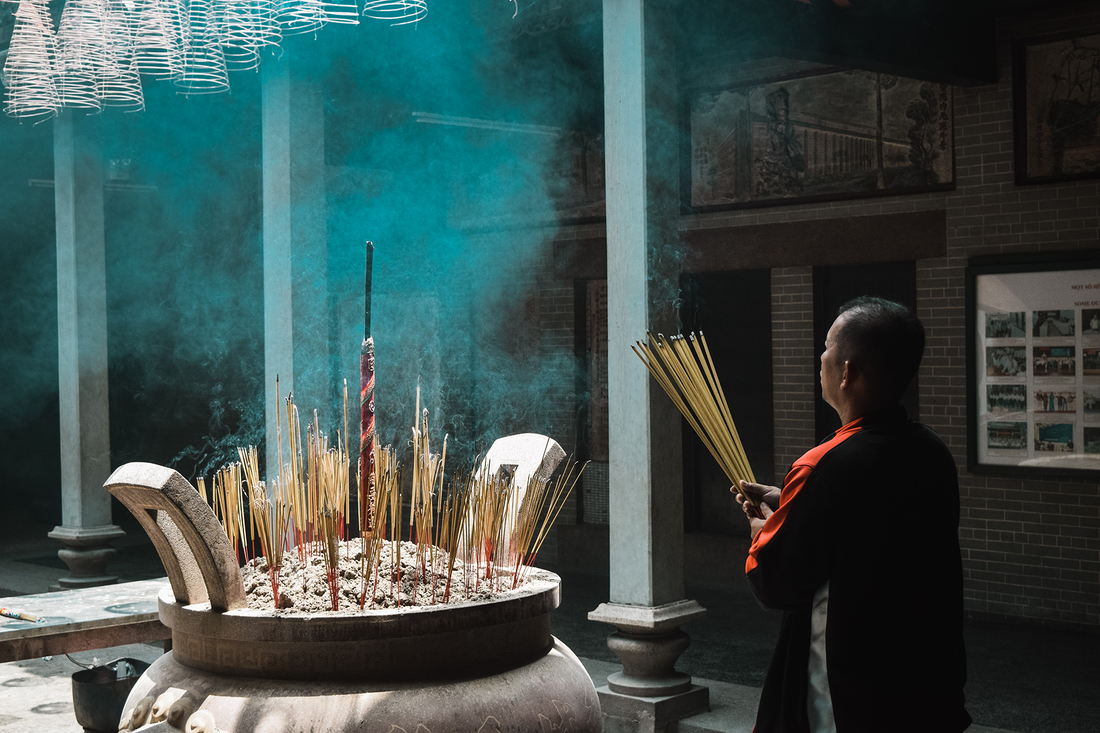If you’ve ever attended a Buddhist ceremony—I’m thinking specifically of Zen, but this is true in much of the Buddhist world—you see there’s a progression that repeats. In a big monastery, there might be so many bells and whistles (so to speak) that you can hardly recognize it as being the same thing you do in your local center or in a corner of your bedroom, but these ceremonies are just variations on a simple pattern.
Here’s how it works: First, an officiant (the abbot, maybe, or you in your own home) makes their way to the altar, does a little bow palm to palm (gassho), offers incense, does another gassho, then gets some space from the altar and, facing the Buddha (or Avalokiteshvara, or Manjushri, or whoever it is), does three bows. At the end of the three bows, either sitting or kneeling (depends on the ceremony), a sutra is chanted—in Zen, by far the one chanted most often is the Heart Sutra, but again, it depends. There might be one person in the room, in which case it’s pretty simple, or there might be three hundred, in which case there are rows of people bowing and chanting in unison, and designated people to carry incense, ring bells, keep time, and so on. No one has nothing to do.
At the end of the sutra or other teaching, there’s a dedication of merit. Here’s the “standard” in the Soto Zen world:
May the merit of this recitation penetrate to each thing in all places, so that we and all beings may together realize the Buddha way.

In other words, “We’re doing this for a reason.” Chanting about compassion or nonduality is a worthy enough endeavor on its own, of course—if we chant the same things over and over again, we memorize them, then internalize them, then find them influencing our thinking moment to moment. It’s worth it. But from the perspective of the tradition, those are considered secondary benefits, side effects of this kind of ritual. The point is that we do this thing that seems so positive and then we give it away. We offer it up—we say to each other and to the universe, “If this has any value at all, we want that value to go to others.”
So…to whom, then? In the dedication above, it’s “all beings,” but a dedication of merit can be much more specific than that. Some are directed at the Buddha himself, some to all the teachers of the past. We can dedicate merit to those who suffer in particular ways: refugees, people in oppressed communities, the sick and dying. Or it could be non-human creatures, the planet itself, those who are not yet born, or even an individual, like a person with tremendous responsibility or the recently deceased. “All beings” obviously covers all that ground, but sometimes we might want to picture the beings to whom we’re offering it all up. It can make the gift, or the idea of the gift, more real.
Following the dedication, there’s an invocation. In Soto Zen, it’s always, always this:
All buddhas throughout space and time;
All honored ones, bodhisattvas, mahasattvas,
Wisdom beyond wisdom, maha prajna paramita.
(Maha prajna paramita actually means “wisdom beyond wisdom,” so we don’t really need to say it, but it’s a nice touch.)
Now, if this is a big ceremony, like the morning service at a monastery, you might repeat this cycle another four or more times, each time with a different sutra and dedication. But if you’ve reached the end, then you finish with three more bows, stand up straight, walk out the door and into your life, where maybe, just maybe, you start offering up your actions. Washing the dishes, crossing the street, hearing the sound of a bird—you give them away. Whatever you produce, whatever comes to you, you know you don’t need to keep it for yourself. You know, in a moment of pride or gratitude or joy, that instead of contracting around that good feeling, you can open yourself up and completely let it go.
You know because you’ve practiced. Wisdom beyond wisdom.

Author: Koun Franz
Koun Franz is a Montana-born Soto Zen priest who trained, taught, and translated in traditional monasteries in Japan. He is the guiding teacher of Zen Nova Scotia; his talks can be found on the ZNS Podcast.

This special Tibetan meditation incense is made from 26 Himalayan herbal ingredients by refugee lay people in H. E. Ayang Rinpoche's monastery in Bylakuppe, India. Made in accordance with 13th century Tibetan teachings from a "secret" recipe. Blue Sky is renowned among the Tibetan community as the highest quality incense available.

Sakura or cherry blossoms, symbolize the fleeting, transient beauty of life and the impermanent nature of all things.

In Buddhist tradition, a seven bowl set is placed on your home altar for water, candlelight, and other traditional offerings. Making shrine offerings is a transformative practice for cultivating generosity and an open heart. Each bowl is engraved with the Wheel of the Dharma and is finely decorated on the base.

Lift your mood and atmosphere with these soothing incense sticks. Perfect for casual yoga, light meditation, or a quiet room. Each bundle contains 15 sticks in total. Choose from Jasmine, Sandalwood, or Rose.

